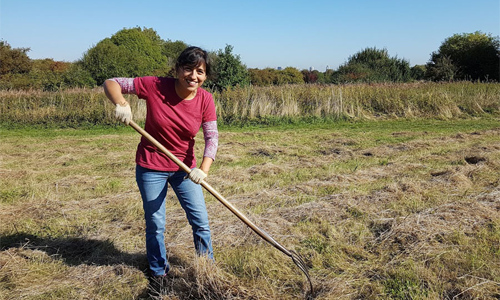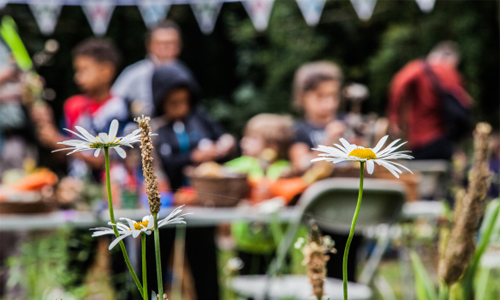Garden Grafts invited beginners and avid gardeners alike to discover the many methods and uses of fruit-tree grafting in the historic grounds of Sutton Ecology Centre. Grafting is a fantastic way to rejuvenate an old apple tree in your garden, or transform a prickly hawthorn into a tasty pear tree. The magic ingredients? Wax, tape, secateurs and a sharp knife!
Our grafters gathered indoors for fear of an imminent cloud burst where they were met with hot drinks, biscuits and a brief introduction to grafting and its history. As luck would have it, the sun broke through as we headed out into the walled garden and began our grafting journey. After some basic instructions on knife safety, bearing in mind that the grafting knife is not sharp enough unless it CAN cut you easily, the first graft technique was demonstrated.
With any graft you have two types of plant; the scion and the rootstock. The SCION is a cutting, usually from last year’s growth, of the plant whose genetic material you want to continue. The ROOTSTOCK is the plant that you’ll graft the scion on to. With any type of grafting, the key is to ensure that all your equipment is sterile AND to maximise the area where the vascular tissues of the two plants meet.
When cutting a scion, always ensure that the cut is smooth and angled so that rain water won’t settle, as this will reduce the chances of rot. Scions are best cut in November from the previous year’s growth and stored in a cool damp and dark place over winter (e.g. moist burlap). This prevents any frost damage and also reduces the chance of the buds opening up before you are ready to graft. Your rootstock will be the tree that you are wishing to replace and would ideally have hardy, vigorous characteristics to maximise the chance of the graft succeeding.
I won’t disclose full details of the grafting methods we covered (you will have to look out for next year’s workshop for that!) but if you want a closer look, our rind and wedge grafts can be spotted in the woodland area of Sutton Ecology Centre!
Our next free workshop, Spiders for Beginners, will take a closer look at our native spiders, dealing with identification, their life history and distribution. A free lunch is included and spaces are limited so book your place here today.
Anna
Biodiversity Gardens Project Officer

Become a volunteer

Sutton nature events





